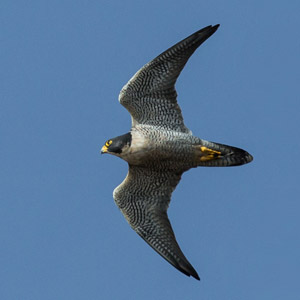Pratique | Débuter
La technique de chasse du Faucon pèlerin

Le Faucon pèlerin (Falco peregrinus) est un chasseur puissant et rapide.Photographie : Mike Baird / Wikimedia Commons
Introduction
Le Faucon pèlerin (Falco peregrinus) est connu pour sa technique de chasse en piqué, pouvant dépasser le vitesse de 200 km/h. L’oiseau ressemble alors à un triangle de plumes profilées, avec ses pattes repliées contre sa queue et ses ailes à demi déployées. À cette vitesse, le coup qu’il assène de sa patte à moitié refermée suffit habituellement à estropier ou à tuer sa proie, quelle que soit sa taille.
Mais la technique de chasse de cette espèce comporte trois phases : le vol de placement, le piqué « ailes-fermées », et l’approche terminale de la proie.
Dans cet article, nous vous proposons une présentation animée de cette technique, basée sur les observations de René-Jean Monneret présentée sur le site personnel de Marie-Christine Dehayes.
Nous l’illustrons par des photos extraordinaires d’un Faucon pèlerin chassant un Pigeon ramier prises par Grégoire Duffez dans l’ouest de la France.
Abstract
Peregrine Falcons are raptors – which means they are birds which hunt and kill for food. They are very well adapted to the hunt, with strong, sharp, curved beaks for tearing flesh, large, keen eyes for viewing prey at great distances, and sharp, powerful claws (called talons) for clutching, and grasping their quarry.
Other birds, such as pigeons, blackbirds, ducks, and pheasants, are the falcons’s usual prey. Peregrines’ incredible speed is the primary weapon used to kill their prey during the hunt. When they get ready to strike, they close their talons and strike the bird in a plunging dive, usually knocking the bird unconscious with a single blow. The force of the initial strike is so severe that the bird is usually killed on impact. As the victim falls through the air the falcon circles back and picks its prey out of the air with its claws. If the bird survives the initial blow, the Peregrine will break its neck with a quick strike of its powerful beak to the bird’s spine.
In this article, we describe you the technics of hunting of the Peregrine Falcon, and presents you some extraordinary photos taken in Western France by Grégoire Duffez of a Peregrine catching a Wood Pigeon.
Poursuivez la lecture de cet article, en vous abonnant dès maintenant !
Découvrez les Archives d’Ornithomedia.com
Pour seulement 10,00 €TTC/an (ou 6,00 € les 6 mois)
Profitez de plusieurs centaines d’articles en accès illimité et sans aucun engagement.
Compléments
À lire aussi sur Ornithomedia.com
Ouvrages recommandés
- Le faucon pèlerin (Broché) de René-Jean Monneret
- Le Faucon : Favori des princes (Poche) de Corinne Beck, Elisabeth Rémy
- Falcons (Belle reliure) de Karen D. Povey
- Le guide ornitho : Les 848 espèces d’Europe en 4 000 dessins de Grant, Mullarney et al.
Sources
- Site perso de Marie-Christine Dehayes : http://perso.orange.fr/marie-christine.dehayes
- Site perso de R. Ferréol : http://mapage.noos.fr/rferreol
- Portail www.oiseaux.net
- Kestenholz M., Schweitze Volgelwarte Sempach, communication personnelle.
- Lovvorni, J.R., Liggins G.A., Borstad M., Calisal S.M. and Mikkelsen A. “Hydrodynamic drag of diving birds : effects of body size, body shape and feathers at steady speed ». The Journal of Experimental Biology 204, 1547–1557 (2001.
- Monneret R.J. (1973)”Techniques de chasse du faucon pèlerin falco peregrinus dans une région de moyenne montagne”, Alauda, Vol. XLI, n°4-1973, 403-412.
- Monneret R.J. “Le faucon Pèlerin” Delachaux&Nielstle
- Tucker, V. A. (1987). Gliding birds: the effect of variable wing span. J. Exp. Biol. 133, 33–58.
- Terrasse J.F. 1970 -Techniques de chasse du faucon pèlerin falco peregrinus et éducation des jeunes. Alauda 38, 186-190.
- Tucker, V. A. (1998). Gliding flight: speed and acceleration of ideal falcons during diving and pull out. J. Exp. Biol. 201, 403–414.
- Tucker, V. A. (2000). Gliding flight: drag and torque of a hawk and a falcon with straight and turned heads, and a lower value for the parasite drag coefficient. J. Exp. Biol. 203, 3733–3744.
- Tucker, V. A., Tucker, A. E., Akers, K. and Enderson, J. H. (2000). Curved flight paths and sideways vision in pérégrine falcons (Falco peregrinus). J. Exp. Biol. 203, 3755–3763.
- Tucker, V. A.(1995). An optical tracking device for recording threedimensional paths of flying birds. Rev. Scient. Instr. 66, 3042–3047.
- Tucker, V. A. (2000b). The deep fovea, sideways vision and spiral flight paths in raptors. J. Exp. Biol. 203, 3745–3754.
- Tucker, V. A., Cade, T. J. and Tucker, A. E. (1998). Diving speeds and angles of a gyrfalcon (Falco rusticolus). J. Exp. Biol. 201, 2061–2070.





Aucun commentaire sur ce sujet
Participer à la discussion !